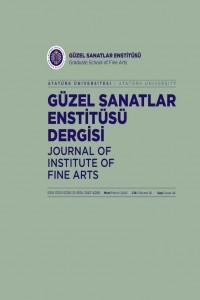Afrika Sanatının Koruyucu İşlevi Ekseninde Nick Cave’in Sanat Pratiği
Bu araştırmada, genellikle heykel, dans ve performans sanatı üzerine üretimler yapan Nick Cave’in “soundsuit” olarak adlandırdığı ses giysilerinin, koruyuculuk işlevi noktasında, Afrika heykeliyle olan analojik ilişkisinin incelemesi amaçlanmıştır.Nick Cave’in, ilki 1992 olmak üzere 2020 li yıllara gelinen süreçte sanatsal üretimlerinde 500’den fazla soundsuit yaptığı görülmüştür. Giyilebilen bu tam vücut heykeller kişinin cinsiyetini, ırkını, kimliğini gizleyerek koruma işlevi görürler. Soundsuitler, danteller, boncuklar, kumaşlar, tüyler, ağaç dalları ve bitpazarından alınma günlük nesnelerle kaplanmış yüzeyleriyle, Afrika danslarında kullanılan kostümlerle benzerlik gösterir. Ayrıca Afrika halklarının korunmayla ilgili içgüdüsel ilişkisi üzerine yaptığı heykellerin Nick Cave’in üretimleriyle anlamsal yakınlığı olduğunu söylemek mümkün görünmektedir.Çalışmada Afrika heykeli ve Nick Cave’in sanat pratiği üzerine alan yazını incelendiğinden doküman analizi yöntemi kullanılmıştır. Bu yöntemle elde edilen verilerin içerik analizi yapılmıştır. Araştırmada sanatçıya ait sanatsal uygulamaların koruyucu bir özellik taşıması Afrika heykeliyle olan ilişkisi noktasında incelenmiştir. Sanat pratiğinde koruyucu işlev vurgusu sanatçının verdiği röportajlarda ve yazılı kaynaklarda görülmüştür.
Anahtar Kelimeler:
Nick Cave, Ses Giysi, Koruyucu Heykel, Afrika Sanatı
Nick Cave's Art Practice within The Scope of the Protective Function of African Art
This study aims to analyze the analogical relationship of the “soundsuits” by Nick Cave, who usually produces works on sculpture, dance and performance art, with African sculpture at the point of protective function, Starting in 1992, Nick Cave has made more than 500 soundsuits until today. These wearable full-body sculptures function to protect the person's gender, race, and identity by hiding them. Soundsuits are similar to the costumes used in African dances, with their surfaces covered with lace, beads, fabrics, feathers, branches, and everyday objects taken from the flea market. Moreover, it is possible to say that the sculptures he made on the instinctive relationship of African peoples with protection have a semantic closeness with Cave's productions. Since the literature on African sculpture and Nick Cave's art practice is analyzed, the document analysis method is used in this study. The content analysis of the data obtained by this method was conducted. In the research, the protective nature of the artistic practices of the artist is examined at the point of its relationship with African sculpture. The emphasis on protective function in art practice has been seen in the interviews and written sources of the artist.
Keywords:
Nick Cave, Soundsuit, Protective Sculpture, African Art,
___
- African dance. (t.y.). Wikipedia içinde. https://en.wikipedia.org/wiki/African_dance
- Cave, N. (1992). Nick cave first Soundsuit [Heykel]. https://publicdelivery.org/nick-cave-soundsuits/
- Cave, N. (2012). Soundsuits Heard [Fotoğraf]. https://publicdelivery.org/%20nick-cave-soundsuits/
- Cave, N. (2013). New York Grand Central Terminali’nde gerçekleştirilen performans [Fotoğraf]. https://www. gettyimages.com/photos/nick-cave-grand-central?phrase=nick%20cave%20grand%20central&sort=mostpop ular
- Cave, N. (2015), Up Right Atlanta performansı [Fotoğraf]. https://fluxprojects.org/productions/up-right-atlanta-nick-cave/
- Cave, N. (2015). TM 13 [Heykel]. http://infinitemiledetroit.com/On_Encountering_Indifferent_Objects.html
- Cave, N. (t.y.). Farklı dönemlere ait Soundsuit örnekleri [Fotoğraf]. http://sumerkatearts.blogspot.com/2012/10/ soundsuits-by-nick-cave.html
- Courtney, C. (2015, November-December). Nick Cave on practice, performance and violence [Monografi]. Adobe Airstream Art Music and Film from West. http://adobeairstream.com/art/nick-cave-on-practice-performance-and-violence/
- Delafosse, M. (2012). African art. Parkstone Press.
- Farting, S. (2017). Sanatın tüm öyküsü (G. Aldoğan & F. C. Çulcu, Çev.). Hayalperest Yayınları.
- Gombrich, E. H. (1999). Sanatın öyküsü (Ö. Erduran & E. Erduran, Çev.). Remzi Kitabevi.
- Güvenkaya, B. C. (2019). Koruyucu heykeller: Yerli halklarda heykel ve heykelin koruyuculuk işlevi (Tez No. 552321) [Yüksek lisans tezi, Mimar Sinan Güzel Sanatlar Üniversitesi]. Yüksek Öğretim Kurulu Tez Merkezi.
- Huntürk, Ö. (2011). Heykel ve sanat kuramları. Şan Matbaası.
- Karafin, A. (2018). An ecstatic embrace: Inside the Soundsuits of Nick Cave. Amykarafin. http://amykarafin. com/pdfs/cave.pdf
- Kinsella, E. (2016, 2 May). How Nick Cave’s Soundsuits made him an art world rock star. Artnet News. https://news.artnet.com/market/nick-caves-soundsuits-made-art-world-rock-star-485522
- Kongo sculptors and ritual specialists. (19. yy). Power figure (Nkisi N’kondi: Mangaaka) [Heykel]. The Met Fifth Avenue, New York, NY 10028, United States. https://www.metmuseum.org/art/collection/search/ 320053
- Lamm, K. (2017). The will to Adorn: Nick Cave’s Soundsuits and queer reframing of black masculunity. Critical Arts South-North Cultural and Media Studies, 31(3), 35-52. https://doi.org/10.1080/02560046. 2017.1383494
- Lee, Y. (2018, 16 Ocak). Nick Cave makes armour for the World’s violence. Canadianart. https://canadianart.ca/interviews/nick-cave-makes-armour-worlds-violence/
- Nganga. (19-mid-20 yy). Power figure: Male (Nkisi) [Heykel]. The Met Fifth Avenue, New York, NY 10028, United States. https://www.metmuseum.org/search-results#!/search?q=power%20figure%20nkisi
- Obkircher, F. (2020, 08 Aralık). US artist Nick Cave explains how to turn despair into hope. RedBull. https://www.redbull.com/gb-en/theredbulletin/nick-cave-soundsuits-hope-art-interview
- Segy, L. (1958). African sculpture. Dover Publications.
- Shakarov, A., & Senatorava, L. (2015). Traditional African art. Mc Farland Company Inc.
- Sollins, S. (2018, 28 Eylül). Interview: Childhood Nick Cave. Art21. https://art21.org/read/nick-cave-childhood/
- Şişman, A. (2006). Sanata ve sanat kavramlarına giriş. Yaz Yayınları.
- Turani, A. (1979). Dünya sanat tarihi (2nd ed.). Türkiye İş Bankası Kültür Yayınları.
- Williams, B. (2015). Medium and meaning in Nick Cave’s Soundsuit. The first-year papers (2010-present) (s. 1-4) içinde. Trinity College Digital Repository. http://digitalrepository.trincoll.edu/fypapers/60
- Wilson, M. (2015). Çağdaş sanat nasıl okunur? E. Koyunoğlu (Ed.), F. C. Erdoğan (Çev.). Hayalperest Yayınevi.
- ISSN: 1300-9206
- Yayın Aralığı: Aylık
- Yayıncı: Atatürk Üniversitesi
Sayıdaki Diğer Makaleler
Sahne Tasarımının Gelişim Süreci İçerisinde Teknik Ve Teknolojinin Önemi
Afrika Sanatının Koruyucu İşlevi Ekseninde Nick Cave’in Sanat Pratiği
Erzurum Ehram Dokuması Üzerine Deneysel Bir Çalışma
Mimari ve Plastik Sanat Akımlarının Gotik ve Rönesans Dönem Koro Müziğine Yansımaları
Geçirgenlik Kavramının Seramik Formlara Yansıması
Pandemi Sürecinde Uzaktan Eğitime İlişkin Müzik Eğitimi Ana Bilim Dalı Öğrencilerinin Görüşleri
Duruş Noktası: Fotoğrafta Karar Anı ve Yorum
Van Hüsrev Paşa Külliyesi Mimari Süsleme ve Onarımı
Grafik Tasarımı Bölümü Öğrenme Çıktılarının 21. Yüzyıl Becerileri Temelinde İncelenmesi
